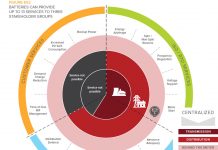John Petersen
I’ve been writing this blog on pure-play energy storage companies for a little over two years. Initially I focused on broad themes like the importance of price and performance and the fact that every industry must master the baby steps before it can try to run. Over time the analysis got increasingly granular as I focused on individual applications instead of the industry as a whole. While I occasionally revisit basic themes like I did in last fall’s Battery Investing for Beginners series, I worry that overly technical discussions of applications are not as useful for investors as they could be.
My readership base has grown exponentially over the last year, which tells me that interest in the storage sector is booming. Since many investors seem to be having a hard time separating the wheat from the chaff, now seems like a good time to revisit the basics for investors who are considering this old-line industrial sector for the first time.
The oil industry and the battery industry are both celebrating sesquicentennials. Colonel Edwin Drake drilled the first commercial oil well in 1858. A year later on the other side of the Atlantic Gaston Planté invented the first rechargeable lead-acid battery. For the last 150 years, oil has been the primary driver of global industrial and economic growth and batteries have been little more than a grudge purchase, devices that nobody wanted but everybody needed. As the world slowly comes to grips with issues like peak cheap oil, climate change and rapid industrialization in Asia and South America, investors are beginning to realize that energy storage will be the beating heart of the cleantech revolution; an enabling technology for more efficient wind and solar power, more efficient transportation and a more efficient and reliable electric grid.
This is not a case of simple evolution; it’s a new industrial revolution where energy storage applications that didn’t exist a decade ago will become hundred billion dollar opportunities over the next 20 years.
The mainstream media is full of stories about gee-whiz energy storage applications that scientists and companies are developing for new markets. The articles usually wax poetic on the benefits while downplaying if not ignoring the risks and costs. They almost never talk about the period of time that will pass between the launch of a technological marvel and the happy day when its manufacturer will turn the corner from hemorrhaging cash to breakeven; or the happier day when it will turn the corner from breakeven to sustained profitability.
Since the fair value of an investment is always equal to the risk-adjusted discounted present value of expected future returns, successful investing is all about timing. Being right too early is no better than being wrong. Investing at the wrong point in the hype cycle can be a grave mistake. In the final analysis knowing what will happen is useless if you don’t have a reasonable feel for when it will happen.
Since 1988 I’ve been convinced that Apple (AAPL) had the best technology for the majority who want to use computers without having to understand their inner workings. Since 2004 the market has agreed with me. From 1988 through 2004, however, I’d have been better off owning Microsoft (MSFT). A true financial genius would have owned Microsoft from 1988 to 2004 and then shifted his portfolio to Apple. I wasn’t that smart.
Most investors are accustomed to IT where Steve Jobs can introduce the iPad in April and Apple can plan on first year sales of 13 million units. Comparable uptake rates are simply not possible in cleantech. The following graph of a generic technology adoption lifecycle is the single most useful image an energy storage investor can sear into his consciousness.

The next graph from hybidcars.com is a close second because it tracks the increase in HEV sales from 1999 through 2009. The important lesson in this graph is that it took HEVs 10 years to advance from the starting point on the Technology Adoption Lifecycle curve to a point where they’re finally approaching ‘The Chasm.’ I’m one of many cheerleaders who believe HEVs should cross ‘The Chasm‘ and become mainstream products, but even my optimism is tempered by reports that HEVs are losing market share while clean diesel sales are soaring.

Once an investor understands these two charts, it becomes relatively easy to answer the $64,000 Question:
“When are emerging energy storage applications likely to transition from the bleeding edge to the leading edge, and from the leading edge to sustained profitability?”
Electric Bikes and Scooters. Americans tend to think of cars when the subject is personal transportation, but electric bikes and scooters are immensely successful in Asia and rapidly becoming mainstream products in Europe. According to Pike Research, electric two-wheeled vehicle, or E2W, sales are currently in the 25 million unit per year range and sales are expected to grow to 80 million units per year by 2016. In Asia, E2W is the Microsoft analog in vehicle electrification; a cheap solution for the masses that has already attained ‘Early Majority’ status.
Stop-start Idle Elimination. Stop-start idle elimination is a baby step toward vehicle electrification that’s been largely ignored by the media. The technology is simple – it turns the engine off when a car is stopped and turns it back on when the driver takes his foot off the brake. Since stop-start systems are extremely hard on batteries, current offerings use two VRLA batteries instead of one flooded battery. Even with dual batteries, automakers have had tremendous problems with battery degradation. To solve the problems, they are actively evaluating a variety of advanced energy storage technologies that promise better performance. Unlike the complex vehicle electrification plans that will depend on uncertain consumer acceptance rates, stop-start is being driven into the market by new fuel economy and CO2 emission regulations. Forecasts predict very rapid stop-start implementation in cars with internal combustion engines. The consensus calls for market penetrations in the 40% range by 2015 with near-universal implementation by 2020. The bottom line is that stop-start is the current Microsoft analog in vehicle electrification; an affordable solution for the masses that has already crossed ‘The Chasm‘ and will attain ‘Early Majority‘ status within five years.
Hybrid and Electric Buses. In recent years a huge amount of work has focused on improving the fuel economy of transit buses. The technical approaches range from hybrids that use supercapacitors or batteries to reduce waste to full electric vehicles. The economics seem to be working for transit system operators and order sizes are increasing rapidly. I believe that hybrid and electric transit buses have recently crossed ‘The Chasm.’ The future is looking very bright and I believe hybrid and electric buses will become mainstream public transit products in the next five years and dominant technologies by the end of the decade.
Plug-in Vehicles. Despite deceptive acronyms and PR claims that tend to confuse rather than enlighten, plug-in vehicles are not an evolutionary development in HEV technology. HEVs use a small battery to minimize wasted energy and improve fuel economy. Plug-in vehicles use a huge battery to replace a fuel tank and substitute electricity from coal for gasoline from oil. So despite the happy talk, plug-in vehicles are at the starting point on the Technology Adoption Lifecycle curve and must overcome six impossible challenges before they can approach ‘The Chasm.’ If those challenges can be overcome, plug-ins may become mainstream products by 2020. For the next decade, however, companies that make plug-in vehicles and the batteries that power them are likely to perform like Apple did in the 1990s.
Grid-connected Storage. The most exciting emerging energy storage applications are grid-connected systems for frequency regulation, short-duration wind and solar power integration and improved power quality. Many believe grid-connected storage markets will be immense once the new systems prove their worth. Like plug-in vehicles, however, grid-connected storage is at the starting point on the Technology Adoption Lifecycle curve. To complicate matters the potential buyers of grid-connected systems are the most heavily regulated and fiscally conservative companies on the planet. Utilities will need years if not decades of demonstration projects and performance testing before they’ll be able to justify implementation decisions to a powerful array of Federal, state and local regulators. The next ten to fifteen years will undoubtedly be a time of intense testing and analysis, but grid-connected systems are unlikely to become mainstream products for another 15 to 20 years
The following graphic is my attempt to put the emerging energy storage markets into perspective in terms of when those markets will hit their stride and transition from the bleeding edge to the leading edge, and from the leading edge to the mundane.

The E2W market is here, its now and its booming. The two best pure plays in that sector are Advanced Battery Technologies (ABAT) and China Ritar Power (CRTP). While Valence Technology (VLNC) has a toehold in the E2W space because of its contracts with Segway and Oxygen SpA, Valence is not currently active in Asia where the bulk of the E2W sales originate.
The stop-start idle elimination market has been flying under most investors’ radar to date but its visibility will ramp rapidly over the next three years as companies like Johnson Controls (JCI), Exide Technologies (XIDE) and Axion Power International (AXPW.OB) begin posting revenue gains from higher per vehicle battery content and higher gross margins on advanced battery systems. While Maxwell Technologies (MXWL) has a toehold in the stop-start market, its supercapacitor-based solution cannot eliminate the engine-off accessory load issues that are the principal cause of start-stop battery degradation.
The hybrid and electric bus market will be fascinating to watch over the next five years. Maxwell Technologies has seen a rapid ramp in its order flow for hybrid transit buses and lithium-ion battery manufacturers including A123 Systems (AONE) and Ener1 (HEV) have experienced similar increases in demand. Other contenders include Valence Technology and Altair Nanotechnologies (ALTI). While my guess is that Maxwell and A123 are likely to be the sector heavyweights, I’d have a hard time picking a clear technology winner today.
Since my crystal ball gets pretty foggy if I try to look more than five years out, I’d rather focus on the bird-in-the-hand investments today and turn my attention to the wild geese categories of plug-in electric vehicles and grid-connected storage in 2020 through 2025 when their futures will be clearer and their valuation premiums more reasonable.
Disclosure: Author is a former director of Axion Power International (AXPW.OB) and holds a substantial long position in its common stock.








While I tend to agree with much of your analysis, are you sure that your projection of e-bike sales by 2016 to 80M units, is correct? I believe that sales this year in China are on target to reach 27/28 million – strong growth after two years when the market went somewhat flat. It seems that Pike is looking at 9% compound growth to 2016 (somewhat rich I think) but even this brings the total to under 50M by 2016. Adoption of e-bikes outside China has been very slow and there is little yet to suggest a major change in the near term.
The numbers are pretty amazing but a 9.4% CAGR is exactly what Pike is predicting. The article includes a link to the summary of their report which I’m too cheap to buy. Their press release for the report is here:
http://www.pikeresearch.com/newsroom/466-million-electric-two-wheel-vehicles-to-hit-the-road-by-2016
If you take the time to register, you can download a free executive summary that provides a bit more detail.
Ultimately it’s conclusions like these that let me be a cynic about plug-in cars and an optimist about battery manufacturers. I just figure the batteries that won’t go into plug-ins will be absorbed by E2W.